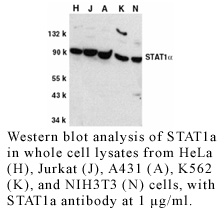Anti-Human Signal Transducer and Activator of Transcription 1
Data
- -
- -
Antibody DetailsProduct DetailsReactive Species Human Host Species Rabbit Immunogen PN:S528 Product Concentration 0.5 mg/ml Formulation This polyclonal antibody is formulated in phosphate buffered saline (PBS) pH 7.4 containing 0.02% sodium azide as a preservative. Storage and Handling This polyclonal antibody is stable for at least one week when stored at 2-8°C. For long term storage, aliquot in working volumes without diluting and store at –20°C in a manual defrost freezer. Avoid Repeated Freeze Thaw Cycles. Country of Origin USA Shipping Next Day Ambient RRIDAB_2831758 Each investigator should determine their own optimal working dilution for specific applications. See directions on lot specific datasheets, as information may periodically change. DescriptionDescriptionSpecificity Rabbit Anti-Human Signal Transducer and Activator of Transcription 1 Alpha (STAT1α) recognizes an epitope near the C-terminus of Human, Mouse and Rat STAT1α. This polyclonal antibody was purified using affinity chromatography. Background STATs (signal transducers and activators of transcription) are a family of cytoplasmic latent transcription factors that are activated to regulate gene expression in response to a large number of extracellular signaling polypeptides including cytokines, interferons, and growth factors. After phosphorylation by JAK tyrosine kinases, STATs enter the nucleus to regulate transcription of many different genes. Among the seven STATs (Stat1, Stat2, Stat3, Stat4, Stat5a, Stat5b, and Stat6), Stat1, Stat3, Stat5α, and Stat5β have a wide activation profile. STAT1 is activated by many different ligands including IFN family (IFN-α, IFN-β, IFN-γ and IL-10), gp130 family (IL-6, IL-11, LIF, CNTF, and G-CSF), and receptor tyrosine kinases (EGF, PDGF, and CSF-1). STAT1 has two forms, the 91 kDa STAT1α and the 84 kDa STAT1β which are encoded by the same gene with splicing variant. PubMed References & Citations1. Leonard, WJ. et al. (1998) Annu. Rev. Immunol. 16:293 2. Schindler, C. et al. (1997) Science 277:1630 3. Schindler, C. et al. (1992) Proc. Natl. Acad. Sci. USA 89:7836 Technical ProtocolsCertificate of Analysis |
Related Products
- -
- -




